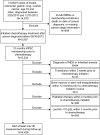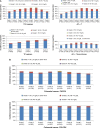Incidence of anemia in patients diagnosed with solid tumors receiving chemotherapy, 2010-2013
- PMID: 27186078
- PMCID: PMC4847604
- DOI: 10.2147/CLEP.S89480
Incidence of anemia in patients diagnosed with solid tumors receiving chemotherapy, 2010-2013
Abstract
Purpose: The purpose of this study was to evaluate and characterize the risk of anemia during the course of chemotherapy among patients with five common types of solid tumors.
Patients and methods: Patients diagnosed with incident cancers of breast, lung, colon/rectum, stomach, and ovary who received chemotherapy were identified from Kaiser Permanente Southern California Health Plan (2010-2012). All clinical data were collected from the health plan's electronic medical records. Incidence proportions of patients developing anemia and 95% confidence intervals were calculated overall and by anemia severity and type, as well as by stage at cancer diagnosis, and by chemotherapy regimen and cycle.
Results: A total of 4,426 patients who received chemotherapy were included. Across cancers, 3,962 (89.5%) patients developed anemia during the course of chemotherapy (normocytic 85%, macrocytic 10%, microcytic 5%; normochromic 47%, hyperchromic 44%, hypochromic 9%). The anemia grades were distributed as follows: 58% were grade 1, 34% grade 2, 8% grade 3, and <1% grade 4. The incidence of grade 2+ anemia ranged from 26.3% in colorectal cancer patients to 59.2% in ovarian cancer patients. Incidence of grade 2+ anemia increased from 29% in stage I to 49% in stage IV. Incidence of grade 2+ anemia varied from 18.2% in breast cancer patients treated with cyclophosphamide + docetaxel regimen to 59.7% in patients with ovarian cancer receiving carboplatin + paclitaxel regimen.
Conclusion: The incidence of moderate-to-severe anemia (hemoglobin <10 g/dL) remained considerably high in patients with solid tumors receiving chemotherapy. The risk of anemia was greater in patients with distant metastasis.
Keywords: anemia; chemotherapy; incidence; solid tumors.
Figures





References
-
- Schwartz RN. Anemia in patients with cancer: incidence, causes, impact, management, and use of treatment guidelines and protocols. Am J Health Syst Pharm. 2007;64(3 Suppl 2):S5–S13. quiz S28–S30. - PubMed
-
- Rodgers GM, 3rd, Becker PS, Blinder M, et al. Cancer-and chemotherapy-induced anemia. J Natl Compr Canc Netw. 2012;10(5):628–653. - PubMed
-
- Dicato M, Plawny L, Diederich M. Anemia in cancer. Ann Oncol. 2010;21(Suppl 7):vii167–vii172. - PubMed
-
- Wu Y, Aravind S, Ranganathan G, Martin A, Nalysnyk L. Anemia and thrombocytopenia in patients undergoing chemotherapy for solid tumors: a descriptive study of a large outpatient oncology practice database, 2000–2007. Clin Ther. 2009;31(Pt 2):2416–2432. - PubMed
-
- Groopman JE, Itri LM. Chemotherapy-induced anemia in adults: incidence and treatment. J Natl Cancer Inst. 1999;91(19):1616–1634. - PubMed
LinkOut - more resources
Full Text Sources
Other Literature Sources

